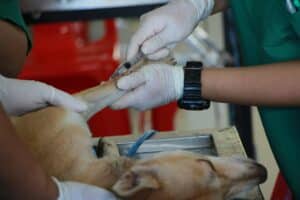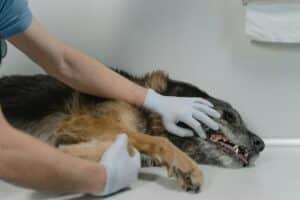Step 1: Recognize the Signs of Worms in Dogs
The first step in addressing worms is knowing how to identify them. While some types of worms may be visible in your dog’s stool or vomit, others may cause symptoms that require a closer look.
- Common Symptoms:
- Diarrhea or soft stool
- Weight loss despite a healthy appetite
- Vomiting (sometimes containing visible worms)
- A bloated or distended belly
- Lethargy or low energy levels
- Itching or scooting around the anus
- Behavioral Changes:
- Restlessness or discomfort
- Increased thirst or unusual cravings
If you’re noticing any of these symptoms and wondering, “Does my dog have worms?”, it’s time to take action.
Step 2: Confirm the Diagnosis with a Veterinarian
If you suspect your dog has worms, schedule a visit to your veterinarian as soon as possible. A professional diagnosis is crucial for identifying the type of worms and determining the best course of treatment.
- What to Expect During the Vet Visit:
- Stool Sample Analysis: Your vet will likely request a stool sample to look for worm eggs or larvae under a microscope.
- Physical Examination: They may check your dog’s overall health, including their weight, hydration levels, and any visible signs of worms.
- Blood Tests: For more advanced cases, blood tests may be conducted to identify specific types of worms, such as heartworms.
Step 3: Administer the Prescribed Treatment
Once your vet confirms the presence of worms, they will prescribe the appropriate treatment. It’s essential to follow their instructions carefully to ensure the worms are fully eradicated.
- Types of Worming Medications:
- Tablets or Chewables: Often flavored to make administration easier.
- Topical Treatments: Applied to your dog’s skin to kill internal parasites.
- Injections: In severe cases, your vet may administer injectable medications.
- Tips for Administering Medication:
- Hide tablets in treats like peanut butter or cheese.
- Use a pill dispenser if your dog resists taking pills.
- Always complete the full course of medication, even if symptoms improve.
Step 4: Clean Your Dog’s Environment
Worms and their eggs can linger in your dog’s surroundings, increasing the risk of reinfection. Thoroughly cleaning and sanitizing their environment is a critical step.
- Indoor Cleaning:
- Wash your dog’s bedding, toys, and food bowls in hot water.
- Vacuum carpets and rugs where your dog frequently lies.
- Mop hard floors with a disinfectant.
- Outdoor Cleaning:
- Scoop and dispose of feces immediately from your yard.
- Avoid allowing your dog to roam in areas where other animals may have defecated.
- Treat the soil with safe, pet-friendly disinfectants if worms are a recurring issue.
Step 5: Monitor Your Dog’s Recovery
After treatment, it’s essential to monitor your dog for signs of improvement and ensure the worms have been eradicated.
- Follow-Up Vet Visits:
- Schedule a follow-up appointment for a second stool test to confirm that all worms have been eliminated.
- Discuss preventative measures with your vet.
- Track Symptoms:
- Keep an eye out for lingering signs like diarrhea, vomiting, or bloating.
- Note any changes in behavior or energy levels.
Step 6: Prevent Future Infections So You Don’t Have to Ask Does My Dog Have Works
Prevention is key to keeping your dog healthy and worm-free. By taking proactive measures, you can significantly reduce the risk of worms returning.
- Regular Deworming:
- Follow your vet’s recommended deworming schedule, typically every 3-6 months.
- Use broad-spectrum dewormers to protect against multiple types of worms.
- Flea and Tick Control:
- Use flea preventatives, as fleas can transmit tapeworms.
- Check your dog’s fur regularly for signs of fleas or ticks.
- Good Hygiene Practices:
- Pick up your dog’s feces promptly and dispose of it properly.
- Avoid allowing your dog to eat raw meat or scavenged food.
- Ensure your dog drinks clean, fresh water during walks or hikes.
Conclusion
Worms in dogs are a common yet treatable issue. By recognizing the symptoms, seeking prompt veterinary care, and following through with treatment and prevention, you can protect your dog’s health and happiness. If you’ve been asking yourself, “Does my dog have worms?”, now you have a clear plan to address the issue. Keep your furry friend safe by staying vigilant and proactive in their care.






